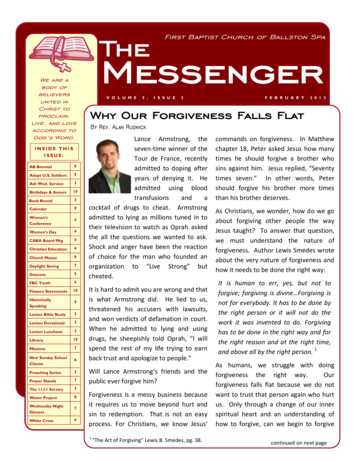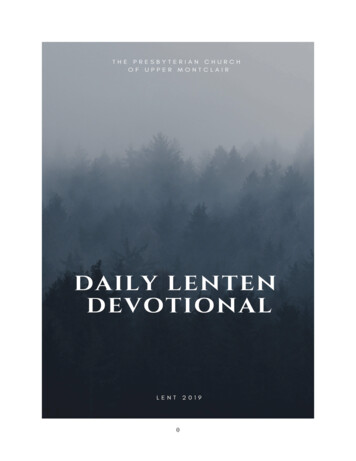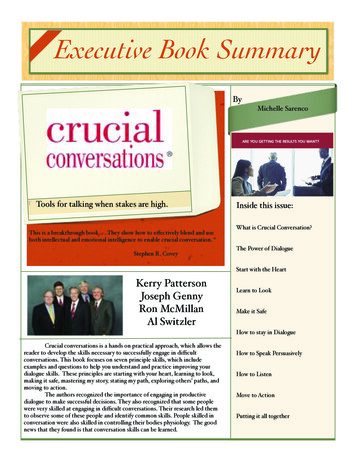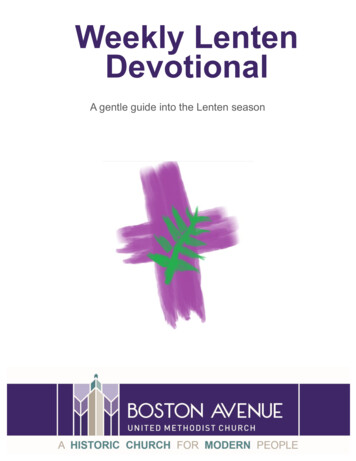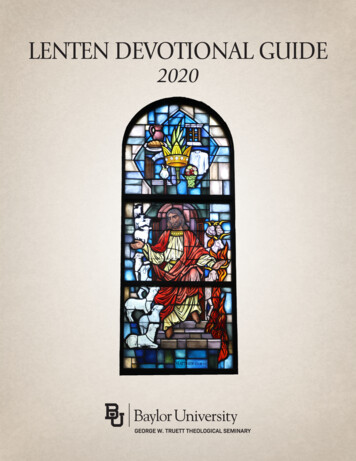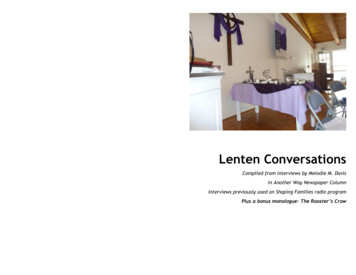
Transcription
Lenten ConversationsCompiled from interviews by Melodie M. Davisin Another Way Newspaper ColumnInterviews previously used on Shaping Families radio programPlus a bonus monologue: The Rooster’s Crow
Lenten Conversations:Stanley Hauerwas on Prayers for Our ChildrenCan you imagine going to bed at night not sure if you or your child willbe alive the next day?Stanley Hauerwas is a renowned theologian, prolific author, and adistinguished professor emeritus from Duke University in Durham,North Carolina.Over the years I’ve been fortunate to interview some folks with namesyou might recognize. Sometimes the interviews were for TVdocumentaries we worked on at Mennonite Media, or for the ShapingFamilies radio program. For the six weeks of Lent I’m sharinghighlights from some of those encounters.I first became aware of Stanley Hauerwas’s writing and work when heand Will Willimon wrote the noteworthy and prophetic book ResidentAliens: A Provocative Christian Assessment of Culture and Ministry forPeople Who Know that Something is Wrong (Abingdon Press) in the late80s. This now being 2017, perhaps I should note that Hauerwas andWillimon were not talking of immigrants here, but rather how Christiansall are perhaps aliens living in a culture away from our true home inGod’s kingdom or heaven.Hauerwas’s lofty books and highly respected teaching didn’t stop himfrom living a nightmare. He endured the difficult personal trauma facingmany families living with someone with bipolar illness. Both he and hisson have deep faith and gratefulness for the prayers of friends andcolleagues who rallied to their support in those days.“Prayer meant everything to me,” Hauerwas said in his interview. “Iknow that I would not have survived without intercessory prayer, I justknow that. So we can always pray for one another in that way.”Fast forward to 2012 when his memoir, Hannah’s Child had just beenpublished, and he was speaking to a group of Mennonites meeting inRaleigh at North Carolina State University. The topic of that book wasmore domestic, not only about Dr. Hauerwas’s childhood, but how hecame to deal with his wife’s mental illness.In Hannah’s Child, he writes about his own mother, named Hannah.Like Hannah in 1 Samuel, chapter 2, Hauerwas’s mother prayed for ason and promised to devote her life to raising that son for God.Hauerwas jokes, “That was perfectly appropriate, but why did she haveto tell me about it when I was just six?” Later in life he learned howthose prayers, and even being told of her dreams for him, surely “had agreat shaping on my life. It took me many years to understand that’s theway it’s supposed to work.”Think of the Psalm that goes, “Your eyes saw my unformed body; allthe days ordained for me were written in your book before one of themcame to be,” (Psalms 139:5). Jeremiah was also told, “Before I formedyou in the womb I knew you, before you were born I set you apart; Iappointed you as a prophet to the nations” (v.1:5).Hauerwas’ father was a brick layer and at first Hauerwas was inclined tofollow in his father’s footsteps. I loved the tribute Hauerwas gave hisfather in our interview:My father was a wonderful, gentle man, who was in a very hardline of work. He was a craftsman of first order, and when I wastaken on the job when I was seven, you have to learn all thesubsidiary skills of the laborer before you’re allowed to laybrick. My father was a little hesitant to teach me because hewanted me to go on to college and didn’t want me into themoney [of bricklaying]. But I learned from my father essentialwork habits that have stayed with me my whole life.I have no doubt that this early introduction to hard work did helpHauerwas as he lived through the manic episodes in his first marriageuntil his wife left him. He also credits his parents as instrumental for hiscalling: “My mother and father exemplified for me a verystraightforward and unapologetic dedication of lives shaped by thechurch and the gospel, which always stayed with me. Their faith alwaysgave them something to do. That is what faith does. It gives yousomething to do. Just think how wonderful that is, to have something todo with your life. You don’t have to make it up.”What were or are your prayers for your children? Reflect on Psalm139:5: “All the days ordained for me were written in your bookbefore one of them came to be.”
Lenten Conversations:Mike Berenstain of “Bear” Book FameI was surprised when I learned that Mike Berenstain was to becommencement speaker at my alma mater, Eastern MennoniteUniversity in 2011. But his son was graduating so I was pleased whenMike took time out of a very busy weekend for an interview for ourlittle radio program, Shaping Families. I had to think how the storiesand artwork he and his parents created were quite significant in shapingmy own little family!Berenstain Bear books were an almost nightly ritual at our house for anumber of years. I still have 19 of the lovable books which teach somany good values, awaiting the years when my own grandsons willenjoy them. Both of the older Berenstains, Stan and Jan, who wrote andillustrated the books, are now deceased (Mike’s father in 2005 andmother in 2012). Mike counts it a privilege to have worked with themafter the books spun off into TV shows and other products. He said hisparents could barely keep up with the demands on their time in the late80s. They never pushed Mike into the “family business” but he chose tostudy illustration in art school, and briefly worked in design for RandomHouse. There he learned the ropes of publishing children’s books.As a kid, Mike was amused when fans would assume the Berenstainbears somehow represented Stan and Jan’s own family. People wouldsay to Mike, “Well, are you Brother Bear?” Mike told me, “I alwayssaid, well, no, I have an older brother. So I must be Sister Bear.” Mikesaid his own kids took bear comparisons mostly in stride, enjoying theattention their grandparents received as the famous illustrator/authors.I was interested in how Mike came to launch a separate line ofBerenstain Bear books which are more directly religious. His father wasculturally of Jewish background and his mother raised Episcopalian.Mike explained that “they taught us ethics from the Judeo-Christiantradition, but they dealt with their mixed marriage by really not teachingus religion.” But as an adult, Mike became a Christian and later inpublishing, he wanted to express his own faith and launched “LivingLights” through Zondervan Publishers.Mike recalled the Berenstains had received an immense amount offeedback from people over the years saying that they would like bookswith a more overt faith message. “A huge proportion of our audience—our most dedicated, faithful audience —were people of very traditionalbackgrounds,” Mike pointed out.There are about 12 original classic Berenstain Bear books that havebeen perennial best sellers. “But of the more recent ones, the LivingLights faith books are the most popular,” Mike commented.It was encouraging to hear that even though he wasn’t taught specificChristian faith stories as a child, his work has now been helpful forparents in raising their children to love God and follow Christ’s basicteachings. Lent and Easter traditions and activities can be special timesto bring attention to Christian faith and stories from the Bible.This author added, “It’s very important that [in teaching good values]you try to give kids books that will give them a story which is attractive,entertaining, and interesting. It’s much less effective to give a kid alecture.” Of course!Mike is my age (born the same month in 1951) and if he is able tocontinue coming up with great story lines and ideas as long as hisparents did (well into their 80s), he won’t be retiring anytime soon. Hismother always quipped when she was asked if she was going to retire,“I think I’ll retire and take up painting!”When I interviewed Mike, his mother was still living. He gave her greatcredit as she continued to paint. He said his mother would always be a“much better illustrator because she had so much more experience.”Mike’s faith story brings me to several verses from the poetry of Isaiah46:4 and 9-10. The verses concern the time when the children of Israelwere in captivity in Babylon. “I will still be carrying you when you areold. Your hair will turn gray, and I will still carry you. I made you, and Iwill carry you to safety. I am God, and there is no other; I makeknown the end from the beginning, from ancient times, what is still tocome.” We can take comfort that no matter what comes in the world, inour families, or with our aging bodies, God is there.Who is “carrying” you? Or how are you supporting others?
Lenten Conversations:Martin Marty on Family TimeOne of the persons I felt most privileged to interview several years agowas Dr. Martin Marty, longtime editor, prolific author, and columnist atChristian Century magazine. That he would agree to an interview with apretty much unknown writer/producer says something about his humblespirit. Among many laurels, The University of Chicago Divinity Schoolnamed their institute for advanced research in the study of religion “TheMartin Marty Center.”As a Lutheran, Marty was named of course for Martin Luther, the greatreformer. 2017 marks 500 years since Martin Luther wrote and nailedhis “95 Theses” (on why the church needed reforming) to the door ofthe Wittenberg church in Germany. What an inspirational model for theyoung Martin Marty.For years I enjoyed his weekly “M.E.M.O” column in the ChristianCentury and now contributes to the Sightings column. I admit that hiswriting is sometimes too thick and academic for my inadequate brain.Yet I will forever treasure his humor, his spirit (he always seems to besmiling as if keeping a secret joke), and his willingness to welcome meinto his Chicago condo and office looking out on a glorious view ofLake Michigan. I recorded an interview for the Mennonite church’sradio program on family issues, a denominational group which Martyrespects highly. Marty also wrote the foreword for my book, WhateverHappened to Dinner: Recipes and Reflections for Family Mealtime.I started by asking Marty where he grew up: “I have a very strong senseof place and heritage, and though I’m very far from it, every day Isomehow draw on my Nebraska roots,” he replied with feeling.The Martys lived in a small town, but the children spent summers on thefarms of relatives. It was the 1930s Dust Bowl era, and Marty says hisparents had to have felt the agony of the Depression: “But we childrenwere kind of protected from that.” His father went to summer schoolevery year, so for six weeks he and his siblings were “farmed out” torelatives (grandfather and an aunt and uncle) on literal Nebraska farms.“They were almost a parallel family to us,” said Marty. They lived 65miles away and it was costly to buy gas to go that far. “So summer wasjust unbroken pleasure on the farm. It was a warm, rich communityenvironment, everybody knew everybody, and took care of each other,”Marty noted.Marty and Elsa (his first wife, who died of cancer), also had the goaland joy of camping in almost every state with five kids plus two whojoined the family as foster children. “We got to all states except Hawaiiand Alaska, (and forgot Delaware!),” he recalled. Marty reflected: “Ifyou take a three-or-so-week camping trip with each other, you really getto know each other. Each had his own assignment on tent set-ups andcamping gear and so on.” Marty is happy to observe his childrenfollowing the camping tradition with their own families.At one point the Martys had seven boys aged 9-14 around the tableevery night. “My sainted wife managed that more than I did, althoughthe kids always remember how every day when I came home, we’d tossthe football. We lived near parks and had a swimming pool; of course alot of friends came over.”Even though Marty traveled a lot because of his professional life, heworked very hard to spend time with the family together, and on anindividual basis. The children took turns traveling with him on businesswhen it could be arranged. They also didn’t watch television during theweek. “They’d watch hockey on Saturday some, but we watched verylittle during the week. We had a reading circle every night around thetable.”As Lutherans I’m sure they observed a “Holy Lent” and read frequentlyfrom the Bible. They enjoyed rich discussions involving theology, theworld, and how Christians should put faith into action. I’m also surethey argued as well (because we all do)—even Mary and Martha in theoft-told story of Jesus visiting their home for a meal when Martha wasall a flutter with meal prep. Mary, however, relished sitting at the feet ofJesus to hear his teachings and stories. Let us ponder Christ’s words tothem: “Martha, Martha, you are worried and upset about many things,but only one thing is needed. Mary has chosen what is better, and it willnot be taken away.” (Luke 10:41-42).What are you most treasured times with others, or with Jesus?
Lenten Conversations:Ken Medema on Really ListeningI first heard Ken Medema’s incredible music and stories at a MennoniteChurch convention. I say incredible because I don’t know of anotherexcellent musician who can listen to someone telling a story and thenmake up meaningful lyrics and simple tunes while singing in front of acrow—and have them turn out so very well. Plus there’s the blind thingbut he’s never let that stop him.Now in his 70’s, Ken performs piano and voice concerts across the U.S.and Canada, and has recorded many albums. One of my close friendsused to be a booking agent for a comedy duo at similar venues andthrough her connections and assistance, I was able to record aninterview with Ken. He broke into a number of on-the-spot made upsongs even during our interview, which I loved! But I was especiallycharmed when he explained how that act of listening so intently until hecaught the “nub” of a story is also a helpful and practical skill inrelationships: with a spouse, children, friends, and even enemies. I daresay it was also a gift that Jesus possessed in spades—something toremind ourselves as we journey through LentFor example, Ken and his wife Jane have greatly differing personalities.Ken is basically an introvert who, while he enjoys people immensely,after leaving a concert or crowd, needs to retreat into his own skin. Hesaid Jane, on the other hand, is such a talkative people-person that shedoesn’t know “what she thinks until she says it.” Jane needs peoplearound with a lot of interaction, because that’s how she thrives. “And Ican’t thrive unless I have lots of time alone,” Ken described.So if Jane, for example (or either spouse in a marriage) is dishing out “acatalog of the ‘you don’ts,’ such as ‘You don’t send me flowers, youdon’t seem to have interest in some of the things I talk about, you don’tseem to like the books I read,’ –how do I respond?” asks Ken.Suddenly in that conversation, Ken said he hears an undertone of “I feelkind of second rate.” He said to look for a key like that in anydisagreement. “I feel second rate” or “less than” or “not appreciated.”Ken went on: “Rather than responding to her with ‘Oh yes I love yourcooking, I love the books you read’—I can respond with ‘I feel kind ofoverwhelmed, because you are so full of energy and ideas and my mindis so slow sometimes, I feel overwhelmed.’” Those kinds of words—overwhelmed, second rate, can be keys to turn a brewing fight into aconversation “and then we can work together at figuring out what’sgoing on rather than just making accusations,” Ken noted.Ken shared how he listens to people and their stories the same way. “Ihear a nub, I hear a little phrase, I hear the central focus of what theperson is trying to say.” And that gives him a key phrase out of which tomake a song!In 2010, Ken and his wife were invited to move in with the family ofone of their children. In this setting of living with loved ones butneeding to work out some of the kinks of three generations in ahousehold, he enumerated the advantages. “Kids are hard to raise,” Kenstated. “But when you’ve got four adults who basically agree on how toraise a kid, when one adult gets tired, another can take over” which is ahuge help. In this setting he and Jane would say to the adult children,“You guys get out of here, go see a movie. We’ll take care of the kids.”Ken remarked, “The relief is palpable. It’s amazing how that works.”He added, “When differences crawl all over us, we both can find oursatisfaction being together among the kids and grandkids, and it bringsus together in better ways.”Ken and his wife have enjoyed many years together even though therewere rough times. Their central focus has been serving God and thechurch. I can think of no better scripture for this Lenten meditation thanJohn 13:34 where Jesus says, “A new commandment I give to you, thatyou love one another: just as I have loved you, you also are to love oneanother.” Or as Ken sung at this point in our conversation:We’re such different people, but we’ve so much to share.Sometimes I’m frightened, and sometimes it’s more than I can bear.And yet I belong to you, and you belong to me,And we both belong to Jesus, so let’s learn how to be a family.How do you practice deep listening with family and friends? Whatlessons have you learned?Visit Ken’s website at http://kenmedema.com/
Lenten Conversations:of the sheriffs took a pistol and cocked it to the side of my head andpulled the trigger. in my mind I was a dead person.”“That hatred frightened me. You get just a little glimpse of it and say, ‘Idon’t want that dark place in my own life.’ I made a bargain with Godthat night, I was so fearful. I was thinking I was gonna be killed. And Isaid, ‘God, if you’ll let me out of this jail, I really want to preach aGospel that is stronger than my race, stronger than my economicinterest. I wanna preach a Gospel that can reconcile black and whitestogether in the body of Christ.’”Speaking was John Perkins, a well known champion of social justiceand reconciliation—who dealt personally with racial brutality inMississippi in the 1960s.What I admire so very much is that out of this experience, John started afoundation which still works at reconciliation between races, justice,and development for all.I did several phone interviews with John Perkins preparing a producerfor a 2001 documentary which aired on ABC-TV, Journey TowardForgiveness. I also heard him speak at an American Bible Societymeeting and shared a taxi ride with him to the airport.John explained further, “Reconciliation to me is not so much for thewhite people I encountered. It is really for myself. I saw that hate in theeyes of the people that tortured me and I could feel myself needing tohate them back.” He went on, “I felt a weight on me. I began torecognize that and really hear the Scripture that says, ‘Unless you canforgive those who trespass against you, how do you expect yourheavenly Father to forgive you?’”John Perkins on ForgivenessHe had one of the most terrifying opening lines ever for a story: “OneJohn grew up in the south where his brother, Clyde, was killed by atown marshall after a disturbance in a movie theater line. Clyde hadfought in World War II and had a difficult time readjusting to life inMississippi where, as a black, he was expected to conform and stayquiet. John was devastated and angry after his brother was killed. Hisparents, who had been sharecroppers in the ‘30s, wisely encouraged himto move to California; eventually he served with the military in Korea,became a Christian, and then married Vera Mae back home inMendenhall, Mississippi, and became a pastor.John believed strongly in encouraging people to help themselves; insuch a role he helped organize an economic boycott. He was brieflyjailed in Mendenhall, and then some students were arrested fororganizing a similar boycott in a nearby city. John drove to the jailhouseto help the students make bond and the sheriff “couldn’t believe that Iwould come back to make bond,” John recalled. “I didn’t have anyunderstanding of the hostility that these people had.”The guards started beating John and the two others who were trying topost bond. “They started beating us the sheriff began to curse us andsay, ‘This is that smart . This is a new ball game [here]. This isnot Mendenhall. You are in my county now.’”The sheriff had cocked the gun at John’s head and at one point a forkwas shoved up his nose. He was kicked repeatedly in the groin. In theeyes of his tormentors, John saw hatred.John emphasized that forgiveness was his way to shed hatred from hisown life. “Forgiveness frees me,” he said. “Not only have I been lovedby God, but I’ve been loved by God’s people.” John used his nightmareto help others latch onto the freeing experience of forgiveness.After hearing John’s story, it restored my hope and faith that peoplecould get along across the many boundaries that divide us. He wentbeyond reconciliation to preach that unless people are empowered topursue economic development, they will continue to struggle in manyrealms. John never received a college degree, but I could see he had thewisdom of a Solomon.I still grieve and stress over the racial injustice we find in our world, andwork to reach across boundaries for better understanding and moreharmony. In this Lenten season as we move closer to the special time ofremembering Christ’s death on the cross, we can reflect on how Jesusalso turned to those who tortured him and forgave them. It’s a way tofind new freedom and love.Who do you need to forgive? Or how can you seek reconciliation?Find out more about the John and Vera Mae Perkins Foundation athttps://jvmpf.org/
Lenten Conversations:Almeda Wright on Helping Teens Live FaithAlmeda Wright is the youngest of the influential Christians we’rehearing from in this series for Lent. So, likely you have not heard of heryet but her influence and vision for helping us understand teens andfaith today will spread as she teaches religion at Yale Divinity School.She is the daughter of a deacon (Baptist) who checked on her religiouslife while she was in college by asking during Sunday evening phonecalls, “How was church?” She loved math and engineering and went toMassachusetts Institute of Technology (MIT) for her undergrad work.Her academic work for her doctorate included extensive study andresearch on faith and youth with youth leaders who participated in afaith based leadership development camp. She asked these youth—admittedly a group inclined to be much more religious than average—how they had experienced God in their personal lives. Over 90 percentsaid they had personally experienced the presence of God: sometimes inthings such as a test in school (her favorite answer) but also in worship,nature, and personal prayer. They recognized God’s blessing in theirlives. They were also the kind of kids who were active and involved inservice projects and helping others.But, these youth rarely if at all connected their personal faith toproblems in the larger culture like racism, drugs, or poverty. Her hunchwas they hadn’t been encouraged to make those connections and tofigure out what Christians could be doing to make a difference. She alsofelt that too often, the personal relationship with Jesus is seen as what’simportant. Wright believes absolutely that a personal bond and belief isimportant, but wants people to take their faith further into the world.Today’s youth (in contrast to earlier times) have parents whose majorcreed may be translated as “play nice in the sandbox,” Wright halfjoked. The religious beliefs of the youth are separated from theirexperiences of an evil like racism, or they absorb that religious faith isjust private. She believes churches and parents can help teach teens thelink between a personal faith and making positive changes in the world.What gave Wright her tremendous sense of the importance of faith in allof life? Her whole extended family—cousins, aunts, and uncles were allpart of her church. “So on Sunday we were going to church and onWednesday Bible study, and on Saturday there was youth group or choiror an usher meeting,” she described. “I remember singing and leadingworship as early as five.”She went to a Catholic school for awhile and there religion was taughtacross the curriculum, including making crosses out of straws ormacaroni, things like that, and was immersed in many religioustraditions and rituals.Yet her path to teaching in the field of religion was not clear cut. Whilestudying engineering at MIT, she took a semester off from her major tostudy art, history, and religions broadly (Christianity and Islam) inSpain. When she got back to MIT, she finished her degree inengineering, but wasn’t sure what to do after.Because of her strong beliefs, she considered ministry, but three thingswere holding her back. “I’m a Baptist and I’m black and I’m from thesouth and that means that there were not women in ministry in mytradition. It wasn’t even something that I could foresee as an option.” Ofcourse in Massachusetts she did see women in ministry, and “all ofthese things came together” to give Wright a new idea of how to serveGod with her life. She was ordained for teaching and pastoral ministry.Most of us don’t have firm ideas while younger of how to put togetherpersonal faith with a path of serving God, but over time it becomesclearer. But it won’t if kids are not exposed to these ideas from an earlyage. “Start children off on the way they should go, and even when theyare old they will not turn from it” the old Proverb goes (22:6, NIV).While that does not always happen, we can use the traditions of Lentand Easter and other religious holidays to “teach your children young”as the old Crosby, Stills and Nash lyrics go. Another line from that songechoes Wright’s message, “You must have a code that you can liveby.” Find a YouTube with Wright at https://youtu.be/DE5fp9VDRGUWhat code do you most want to instill in your children orgrandchildren?
Bonus: A Lenten Monologue: The Rooster’s CrowMe and my big mouth.My mom always said I got it from Dad’s side. My dad always said I gotit from Mom’s side. It doesn’t matter whose side I got it from, but mymouth could sure get me in trouble. You might know me as the disciplePeter, in the Bible.But you have to understand, I didn’t really know then what I know now.Even when I lucked out when Jesus asked who we thought he really wasand I responded, “You are the Christ!,” he praised my answer but Idon’t think I really understood what I’d said. I mean I felt that I spokethe truth, but didn’t really grasp it. That’s why I messed up so soon rightafter, scolding our master for talking about how he was going to bekilled and he rebuked me, “Get behind me, Satan.” That was the lowestI ever felt—until the crow of the cock.But the really bad part was he said I was gonna do it. And if you’ve everknown someone like me, the worst thing you can do is tell me I’m goingto react a certain way. He said we would all fall away and old bigmouth-Peter had to say, “Nope, not me.”“I tell you the truth,” Jesus answered with a kind, knowing, motherlyface, “that tonight before the rooster crows, you’ll disown me threetimes.” And we all swore we never would, like a bunch of silly sheep.And then that servant girl by the fire. As soon as I saw her therewatching me, I knew she’d start grilling me, and it would be all overtown, and I just wanted to get her off my back. I said, “I don’tunderstand what you’re talking about!” And then someone said wesounded like we were from his part of the country and another saidsurely we were Jesus’ disciples.“Man!” I swore. “I do not know that man!”And then came the piercing crow of the cock.The previous three years passed before my eyes like I was dying. I wasdying inside. I thought of the day my brother and I first met Jesus. Andthe day he came to my mother-in-law’s house, and healed her! And thenight we thought we were all dying on the lake, or the times we’d allend up at someone’s house and have those wonderful all-night talksaround a fire.The stories! What a way with words. And the way he put thosePharisees in their place—and anyone, really; even his family andfriends, if the occasion called for it. A master of words. And kindness.His way with children. The mountain top with Elijah and Moses! Thatday at Caesarea Philippi. Sigh. The best three years of my life.To deny all that, that was about as low as a friend could go. But thenyou wouldn’t know anything about that, would you? You’re better thanthat. But I’m so glad I didn’t do what Judas did. I was tempted though,you know, to do myself in rather than see the pained look in his eyesafter my denial.Then we had that awful episode in the Garden—I mean, here was ourbest friend, and leader, who meant everything to us, and we all keptzonking out on him. It was like trying to keep awake in synagogue, andwe felt so guilty but just couldn’t help it. (In our defense, he did keep apretty demanding schedule.)I’ll make it up to him. This big old mouth will make it up to him, or dietrying. I will make it up to him. Just you see. Easter’s coming!And then his arrest, and everything happened so fast, and our dream wasjust falling apart—it was like a nightmare, everything all confused, wedidn’t know what was happening.Another Way is a column by Melodie Davis, in syndication since1987. She is the author of nine books. Another Way columns areposted at FindingHarmonyBlog.com a week after newspaperpublication. Copyright 2017 Melodie M. Davis. All right reserved. Foradditional copies email anotherwaymedia@yahoo.comBiblical references: Matthew 16: 16 and 23; 26:34; Luke 22:54-62
The topic of that book was more domestic, not only about Dr. Hauerwas’s childhood, but how he came to deal with his wife’s mental illness. Hannah’s Child, he writes about his own mother, named Hannah. Like Hannah in 1 Samuel, chapter 2, Hauerwas’s mother prayed for a son and promised to devo




